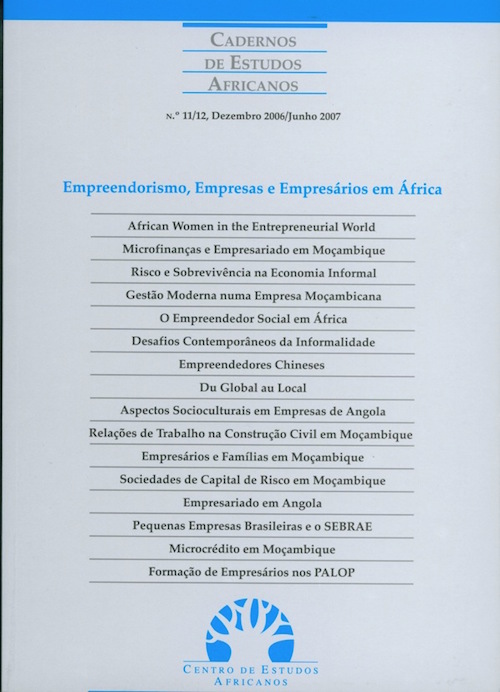Venture Capital Firms in Mozambique
DOI:
https://doi.org/10.4000/cea.954Keywords:
Investimento, Capital de Risco, MoçambiqueAbstract
The text constitutes a synthesis of a study that analysed in a comprehensive way the venture capital activity in Mozambique over three years. The central aim of the study was to evaluate if the local Venture Capital firms (VCs) performed their activities following the classical model or if there was an adjustmentof their proceedings in response to specific aspects of a less developed economy. The study was based in previous investigations carried out in Portugal and in South Africa, but it enlarged their scope when considering the industry environmentalcontext. The results observed the existence of a not so favourable environmental context for the industry growth and a significant evolution in the policy followed by the VCs. Amongst other aspects, the study suggested that the VCs embraced a more flexible approach, without, however, this meaning the adoption of models applied in less developed countries.
References
Aylward, A. (1998), Trends in Venture Capital Finance in Developing Countries, IFC Discussion Paper 36, World Bank.
Bentes, S.(1997), O Capital de Risco em Portugal: Uma Actividade Emergente, dissertação de mestrado, Lisboa, ISCTE.
Berger, A. N., e Udell, G. F. (1998), «The economics of small business finance: the roles of private equity and debt markets in the financial growth cycle», Journal of Banking and Finance, vol. 22.
DOI : 10.2139/ssrn.137991
Ellis, S., e Fauré, Y.-A. (2000), Empresas e Empresários Africanos, Lisboa, Editora Vulgata.
Gibson, T. (1999), Equity Investment for Small and Medium Enterprises in the Newly Independent States, Eurasia Foundation Publication.
Guidotti G., e Sagari, S. (1991), Venture Capital Operations and Their Potential Role in LDC Markets Country, Economics Department, The World Bank WPS 540.
Hellmann, T., e Puri, M. (2002), «On the fundamental role of venture capital», Economic Review – Federal Reserve Bank of Atlanta,vol. 87 (4), p. 19.
INE, (2003), «CEMPRE – Censo de Empresas: resultados preliminares», Instituto Nacional de Estatística, documento disponível em .
Jeng, L. A., e Wells, P. C. (1998), «The determinants of venture capital funding: evidence across countries», documento disponível em .
Keuschnigg, C. (2003), «Public policy and venture capital backed innovation», RICAFE – Risk Capital and the Financing of European Innovative Firms, Working Paper 004.
DOI : 10.2139/ssrn.401821
Knight, R. M. (1994), «Criteria usedbyventure capitalists: acrosscultural analysis», International Small Business Journal, London, vol. 13 (1), pp. 26-38.
Kortum, S., e Lerner, J. (1998), «Does venture capital spur innovation?», National Bureau of Economic Research, NBER (Proquest doc ID: 4671068).
DOI : 10.1016/S1048-4736(01)13003-1
Leitinger, R., e Schöfer, P. (2002), «Framework for venture capital in the accession countries to the European Union», EFMA 2002, London Meetings.
Megginson, W. L. (2004), «Towards a global model of venture capital?», Journal of Applied Corporate Finance, vol. 16 (1), pp. 89-107.
DOI : 10.1111/j.1745-6622.2004.tb00599.x
Taylor, M. (2001), A Comparative Study of the South Africa Venture Capital and Private Equity Industry with Special Reference to the Investment Decision-Making Process, dissertação de mestrado, Cidade do Cabo, University of Cape Town.
UNCTAD (2001), Improving the Competitiveness of SMEs in Developing Countries: The Role of Finance to Enhance Enterprise Development, United Nations Conference on Trade and Development, Genebra, United Nations.
World Bank (2002), Mozambique Industrial Performanceand Climate Assessment 2002, RPED – Regional Program in Economic Development.
World Bank (2003), Mozambique Industrial Performanceand Climate Assessment 2003, RPED – Regional Program in Economic Development.
Downloads
Published
Issue
Section
License
Copyright (c) 2016 Cadernos de Estudos Africanos

This work is licensed under a Creative Commons Attribution-NonCommercial-ShareAlike 4.0 International License.
I authorize the publication of the submitted article/review of which I am the author.
I also declare that this article is original, that it has not been published in any other way, and that I exclusively assign the publication rights to the journal Cadernos de Estudos Africanos. Reproduction of the article, in whole or in part, in other publications or on other media is subject to the prior authorization of the publisher Centro de Estudos Internacionais do Iscte - Instituto Universitário de Lisboa.


